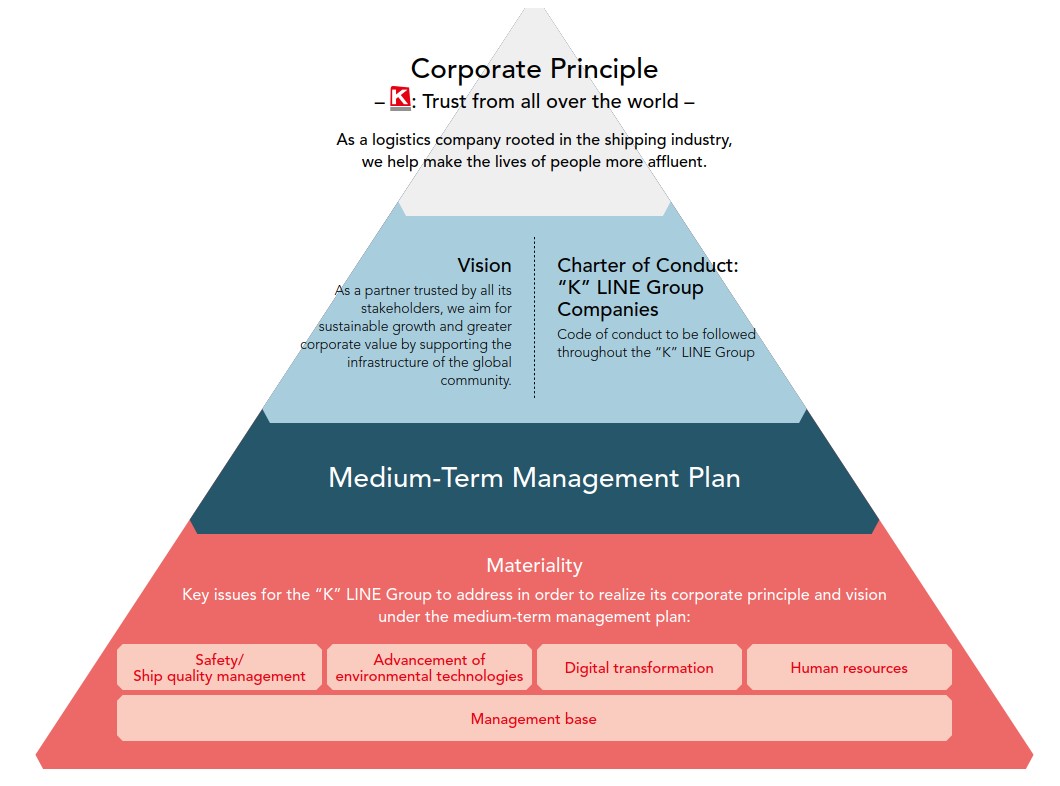These 12 material issues have been categorized into five areas, including safety / ship quality management, advancement of environmental technologies, digital transformation, and human resources—the four pillars of our functional strategy for a solid business foundation to realize the business strategies set forth in our medium-term management plan—and management base, which serves as the foundation of the four pillars. The Group positions materiality as a set of key issues to be addressed in order to realize its corporate principle and vision, contribute to solutions for social issues, and achieve sustained growth and improve corporate value under the medium-term management plan.
|
Category |
Material Issues (Actions for resolving social issues) Related SDGs |
Basic Policy |
|
Management base |
Respect for human rights sdgs05e sdgs08e sdgs10e |
Promote initiatives to respect the human rights of all stakeholders involved in the “K” LINE Group’s business activities. |
|
Reinforcement of corporate governance sdgs16e sdgs17e |
To fulfill its corporate social responsibility, respond to the trust of shareholders and other stakeholders, and achieve sustainable growth, we will thoroughly enforce corporate ethics across the entire Group, build an organic and effective governance framework, and continue striving to enhance corporate value in conjunction with strengthening our earnings and financial structures. |
|
|
Promotion and reinforcement of compliance sdgs16e |
Comply with applicable laws, ordinances, rules and other norms of behavior in both the domestic and international community, and conduct its business activities properly in good faith through fair, transparent, and free competition. |
|
|
Safety/Ship quality management |
Promotion of safety in navigation and cargo operations sdgs07e sdgs13e sdgs14e |
Make the safe operation of vessels and the safety of crew and cargo the top priority, while striving to provide higher quality, safer, and more optimal services with the customer first in mind. |
|
Advancement of environmental technologies |
“K” LINE low-carbon and carbon-free transition sdgs07e sdgs09e sdgs11e sdgs12e sdgs13e sdgs17e |
Toward the Group policy of net zero GHG emissions by 2050, promote environmental impact reduction activities across the entire supply chain and contribute to the realization of a global decarbonized society. |
|
Supporting the development of a low-carbon and carbon-free society sdgs07e sdgs09e sdgs11e sdgs13e sdgs17e |
||
|
Reducing “K” LINE’s impact on the sea and air to zero sdgs03e sdgs11e sdgs12e sdgs14e sdgs15e sdgs17e |
Consider all environmental risks in business activities and take countermeasures while promoting biodiversity conservation and initiatives toward a sustainable society. |
|
|
Promotion of innovation sdgs07e sdgs09e sdgs11e sdgs12e sdgs13e sdgs14e sdgs15e sdgs17e |
||
|
Digital transformation |
Pursue innovation in safety, environment, and quality to contribute to the realization of a low-carbon and carbon-free society. |
|
|
Reinforcement of response to digital transformation (DX) sdgs07e sdgs08e sdgs09e sdgs12e sdgs13e sdgs14e sdgs15e sdgs17e |
Further advance the digitalization of information, business processes, and vessels, and enhance added value as a source of competitiveness by refining the core values of safety, environment, and quality through the use of data and digital technologies. |
|
|
Human resources |
Diversity & inclusion sdgs05e sdgs08e sdgs10e |
Position diversity as a “source of competitiveness,” and conduct both new graduates and mid-career hiring without regard to nationality, educational background, gender, or work area (administrative or technical). Respect the diversity of values generated through these efforts. Promote further diversity, including encouraging men’s participation in childcare and fostering unity and integration with staff of overseas subsidiaries through “K” LINE UNIVERSITY. |
|
Shaping of working environment and promotion of health management sdgs03e sdgs05e sdgs08e sdgs10e |
Respect the dignity, individuality, and diversity of members of the “K” LINE Group, work to maintain and improve a safe and comfortable workplace environment, and aim to realize a more enriched life through initiatives such as childcare and nursing leave systems, compliance consultation desks, measures against overwork, stress checks, and mental health seminars. |
|
|
The securing & development of human resources sdgs05e sdgs08e |
Work to quantitatively and qualitatively secure and develop human resources corresponding to the demands of each business portfolio to enhance both social and economic value. In addition to hiring new graduates, conduct year-round mid-career hiring and implement diverse training programs aimed at developing “human resources who can lead sustainable growth and transformation of the business” and “human resources who can flexibly respond to changes in the business environment.” |
“K” LINE’s materiality is positioned as key issues to address in order to realize its corporate principle and vision based on the medium-term management plan, achieve sustainable growth, enhance corporate value, and contribute to social issues.
Namely, we aim to ensure the sustainability of the “K” LINE Group, society, and the environment.

When identifying material issues, the Group referred to various sources of guidance related primarily to corporate social responsibility (CSR), including ISO 26000 and the OECD Guidelines for Multinational Enterprises. While considering Sustainable Development Goals (SDGs) and other social issues, we analyzed and evaluated materiality from the two perspectives of importance to the Company (importance from a business perspective)
and importance to society (importance from a stakeholder perspective), in addition to factors such as their alignment with our business strategy and their impact on value creation.


- Create a list of social issues with a focus on the Sustainable Development Goals (SDGs) (extensive list of 115 items in total)
- Narrow down the list of social issues, taking into consideration their relevance to the Company’s businesses and their uniqueness to the maritime industry (short list of 50 items in total)

- From the following perspectives, evaluate the importance of the 50 social issues shortlisted in Step 1:
- Importance to the Company
We evaluated the impact of each social issue on the Company’s corporate value from the perspective of risks and opportunities. We also administered a survey to our Group executives and employees to gather their opinions on social issues to be addressed by the Group on a priority basis. - Importance to society
We analyzed the impact of each social issue on key stakeholders of the Group (customers, investors, employees, local communities, and global society) from the standpoint of each stakeholder.
- Importance to the Company

- In Step 2, we positioned items of high importance to both the Company and its stakeholders as social issues that have a high impact on the Company’s corporate value. These have been further consolidated into a total of 12 actions for resolving social issues in order to create a materiality proposal.
- A dialogue is held between outside experts and the Company’s management to exchange opinions on the materiality proposal.
- The materiality proposal is finalized based on the aforementioned dialogue. This proposal is then discussed by the Corporate Sustainability Management Committee, and a final decision is made at the Management Conference, after which it is reported to the Board of Directors.
The “K” LINE Group sets goals and indicators (KPIs) that are aligned with each materiality theme and monitors progress through the Corporate Sustainability Management Committee, chaired by Representative Executive Officer, President & CEO.
KPI performance is reported annually to the Committee where each KPI is reviewed as needed.
|
Material Issues |
Themes |
KPIs |
Medium- to Long-term Targets |
Achievement Status in FY2024 |
FY2025 Targets |
|
Respect for human rights |
Raising supplier awareness |
Percentage of supplier surveys conducted |
Covering the top 80% of transaction value by 2026 |
Not implemented |
Covering the top 50% of transaction value |
|
Raising internal awareness |
Percentage of participants taking e-learning courses on human rights |
Overall participation rate:100% |
Cumulative participation rate: In-house 89.5%, Group companies in Japan: 86.4%, Group companies overseas: 93.1% |
Overall participation rate: 90% or higher |
|
|
Reinforcement of corporate governance |
Principles of CG Code |
Compliance ratio of CG Code principles required for listed companies on Prime Market of Tokyo Stock Exchange |
Continues 100% compliance |
100% compliance |
100% compliance |
|
Board of Directors’ effectiveness |
Implementation and disclosure of the Board of Directors' effectiveness evaluation |
Ongoing implementation on an annual basis |
Due to changes in governance structure, evaluation through an interview format has been postponed to FY2025, and in FY2024, it was conducted through a questionnaire format |
Conducting effectiveness evaluation through interviews |
|
|
Board of Directors’ effectiveness |
Periodic review of issues set out in the Board of Directors' effectiveness evaluation |
Ongoing quarterly reviews and feedback to the Board of Directors |
Conducted 4 reviews (July and October 2024, February and April 2025) |
Conduct quarterly reviews and provide feedback to the Board of Directors |
|
|
Promotion and reinforcement of compliance |
Result indicators |
Number of serious compliance violations |
0 cases |
0 cases |
0 cases |
|
Raising internal awareness |
Percentage of participants attending compliance training |
Maintain a continuous overall participation rate of 90% or higher |
Participation rate: 100% |
Participation rate: 100% |
|
|
Promotion of safety in navigation and cargo operations |
Accidents |
Serious maritime accidents |
0 cases |
0 cases |
0 cases |
|
Delay |
Delay time due to mechanical failure |
10h per vessel p.a. |
7.55h per vessel p.a. |
10h per vessel p.a. |
|
|
“K” LINE low-carbon and carbon-free transition |
Result indicators |
CO2 emission efficiency (vs2008) |
50% reduction by 2030 |
Improved by 42% |
Proceed with initiatives based on medium- to long-term targets |
|
Total CO2 emission volume (vs 2008) |
Achieve net zero by 2050 |
Reduced by 49% |
|||
|
Fuel conversion |
Number of LNG-fueled vessels introduced |
2030: 35, 2040: 35, 2050:10 |
9 vessels |
||
|
Number of ammonia- / hydrogen-fueled vessels introduced |
2050:200-250 |
0 vessels |
|||
|
Supporting the development of a low-carbon and carbon-free society |
Environmental preservation activities |
Number of forest conservation activities conducted |
Once per year |
Once per year |
Once per year |
|
Reducing “K” LINE’s impact on the sea and air to zero |
Marine pollouion |
Oil spill accidents |
0 cases |
0 cases |
0 cases |
|
Reduce impact |
Installation of ballast water treatment systems |
100% by June 2024 |
100% |
Medium- to long-term targets achieved |
|
|
Promotion of innovation |
Introduction of new state-of-the-art vessels |
EEDI regulation values for new vessels ordered by the end of the year |
EEDI Phase 3 and more |
100% |
Medium- to long-term targets achieved |
|
Wind power and others |
Instllation of "Seawing" |
2030: 50 vessels |
0 vessels |
Proceed with initiatives based on medium- to long-term targets |
|
|
Operation efficiency |
Installation of Kawasaki Integrated Maritime Solutions to medium- to long-term charter vessels |
100% |
98% |
100% |
|
|
Reinforcement of response to digital transformation (DX) |
Humen resource development |
Number of certified DX utilizers |
100 personnel by the end of FY2025 |
15 personnel |
100 personnnel |
|
Diversity & inclusion |
Gender |
Female employees comprising of managerial positions* |
15% (by FY2026) |
7.4% |
15% (by FY2026) |
|
Recruitment format |
Ratio of mid-career hires among managers |
- |
17.8% |
- |
|
|
Ratio of mid-career hires among employees in service |
- |
Seafarer: 2.0% / Onshore: 23.0% |
- |
||
|
Shaping of working environment and promotion of health management |
Labor |
Average monthly overtime working hours* |
Under 30 hours |
7.5 hours |
Under 30 hours |
|
Flexible workstyle |
Ratio of male employees taking childcare leave* |
50% |
81.9% |
50% |
|
|
Mental well-being |
Stress check examination rate |
90% |
Seafarer: 96.4% / Onshore: 97.0% |
Seafarer: 90% / Onshore: 90% |
|
|
The securing & development of human resources |
Recruitment format |
Ratio of mid-career hires among managers |
- |
17.8% |
- |
|
Ratio of mid-career hires among employees in service |
- |
Seafarer: 2.0% / Onshore: 23.0% |
- |
||
|
Humen resource development |
Training cost per employee (Onshore personnel) |
- |
208 thousand yen |
322 thousand yen |
* The targets set in the Action Plan to Promote the Active Participation of Women and Support the Development of the Next Generation were formulated in March 2025.
The “K” LINE Group’s management capital lies in technologies for safety in navigation and cargo operations and expertise accumulated over many years. We possess human resources and organizations that transform these capabilities into value that meets the unique needs of our customers. As a result, the strong partnerships we have forged with acquired customers are important capital assets that underpin our business activities. Fusing these capital assets leads to growth for the “K” LINE Group and greater corporate value. We aim to augment these assets in accordance with our corporate principle: “As a logistics company rooted in the shipping industry, we help make the lives of people more affluent.”
| Financial Capital | Enhancing of power and maintaining both capital efficiency and financial soundness based on an awareness of optimal capital structure and cash flow | The “K” LINE Group unveiled its medium-term management plan in May 2022, having observed major improvements to its financial position through business improvements. The Company announced plans to proactively return value to shareholders, while monitoring cash flow for the portion of capital that exceeded requirements for investing to enhance corporate value and maintain a healthy financial position. Now, in the third fiscal year of the medium-term management plan, earnings are higher than forecasted, mainly in our own businesses. Management will review its outlook for operating cash flow through 2026, investment plans, and targets for shareholder returns. We are committed to advancing business management by introducing management indicators for each business while keeping the cost of capital in mind. |
| Human Capital | People and organizations that continuously support logistics infrastructure in global society |
Hiring and training personnel who support all-important safety in fleet navigation, lead change, and sustain growth in our businesses, and capably address changes, in the business environment is an issue of utmost importance to the “K” LINE Group. We strive to create a work environment where employees with diverse values can thrive and apply their abilities. |
| Equipment Capital | Fleet with appropriate flexibility to manage business strategy |
The “K” LINE Group has been advancing various initiatives to achieve the newly set revenue and expenditure targets for fiscal years 2026 and 2030. These include focusing on the growing coal & iron ore carrier, car carrier, and LNG carrier businesses, introducing environmentally friendly ships such as LNG and ammonia carriers, participating in new business areas contributing to society’s low-carbon and carbon-free transition, replacing existing vessels, strengthening cost-competitiveness through fleet upsizing, ensuring fleet flexibility in light of the risk of a retreat in demand, and organizing fleets capable of meeting diverse transportation needs, including High & Heavy cargo. |
| Intellectual Capital | Evolving environment / technology / innovation |
The “K” LINE Group is keen to provide top-class industry solutions by addressing environmental needs for a low-carbon and carbon-free footprint not only at “K” LINE but also among customers and throughout society; by developing zero-emission vessels, including the establishment of a fuel supply network; and by deploying advanced digital technologies for autonomous navigation, breakdown prediction, and environmentally friendly systems such as Seawing and Kawasaki Integrated Maritime Solutions. Through these initiatives, we are refining our core values in safety, quality, and the environment. |
| Social and Relationship Capital |
Solid customer base and partnerships backed by experience | Building on a customer base established through our track record of safe transportation, we aim to strengthen relationships with customers who share our view that low-carbon and carbon-free initiatives are a growth opportunity. In addressing social issues such as decarbonization, we participate in councils and joint research with both domestic and international partners. The liquefied CO2 transportation business aims to contribute to carbon neutrality, taking advantage of know-how and safe operation experience nurtured through the liquefied gas carrier business of the “K” LINE Group and partnership with existing customers. |
| Natural Capital | Contributing to reduction in environmental impact on the sea and air |
As a company for which oceans, a form of natural capital, are its business area, we strive to balance our ongoing developments and contributions to a sustainable society. Under the “K” LINE Environmental Vision 2050, we are committed to reducing environmental impacts, such as moving toward low-carbon and carbon free operations and society as a whole, and conserving biodiversity and the atmospheric environment. |
